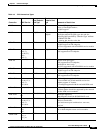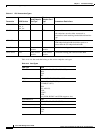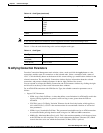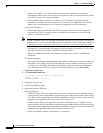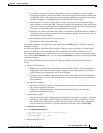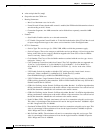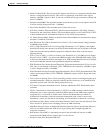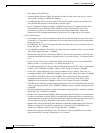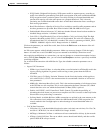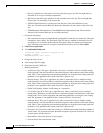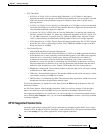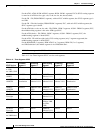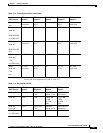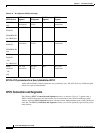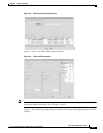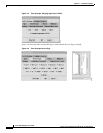
4-29
Cisco WAN Manager User’s Guide
Version 10.5, Part Number 78-12945-01 Rev. D0, August 2003
Chapter 4 Connection Manager
PVC Connections Supported by Release 10 of CWM
–
WFQ Enable: Weighted Fair Queuing. WFQ queues traffic in separate queues, according to
traffic class definition, guaranteeing each queue some portion of the total available bandwidth.
WFQ recognizes when a particular queue is not fully utilizing its allocated bandwidth and
portions that capacity out to the other queues on a proportionate basis. This is done by
portioning out available bandwidth on the basis of individual information flows according to
their message parameters.
–
Best Effort Indicator: A Quality of Service Class in which no specific traffic parameters and no
absolute guarantees are provided. Best Effort includes UBR and ABR Service Types.
–
Enable/disable Discard Alarm per VC: Indicates whether Discard Alarm has been enabled or
disabled. Range and units: 1=enabled; 2=disabled.
–
Cosb CLP (1) High Threshold: Class of Service Buffer- Cells Loss Priority High. The high
hysteresis threshold at which CLP (1) cells will be discarded. The cells will continue to be
discarded until the CLP_LO threshold is reached. This value is a percentage of MAX_CELL
THRESH. 1000000 is equal to 100%. Range and units: 0-1000000.
Click on the parameter you would like to edit, then click on the Edit button at the bottom of the All
Parameters window.
An Edit screen appears with all editable parameters. Make any necessary changes. Click the Apply
button. All values are saved. Click O.K. and you are returned to the Modify Connection screen.
After applying modifications to a connection, you can save changes to a connection template for later
use by clicking Save Template. Also, you can select Load Template to retrieve a previously modified
connection template.
For an ATM-ATM connection with ABR Service Type, the editable connection parameters are as
follows:
• Ingress UPC Parameters
–
PCR0+1(cps): Peak Cell Rate- A value that defines a rate limitation for ATM traffic used in the
ingress policing algorithm. In general, traffic arriving at rates greater than the PCR are
discarded.
–
CDVT0+1(usec): Cell Delay Variation Tolerance for the first leaky bucket, which applies to
cells with CLP(0+1). CDVT is the maximum time for accumulated violations of cell-arrival
time parameters.
–
MBS(cells): Maximum Burst Size in cells. This is the maximum number of cells that may burst
at the PCR but are still compliant. This is used to determine the Burst Tolerance (BT) which
controls the time scale over which the Sustained Cell Rate (SCR) is policed.
–
Enable AAL5 FBTC: AAL5 Frame Basic Traffic Control: To enable the possibility of
discarding the whole frame, not just one non-compliant cell. This is used to set the Early Packet
Discard bit at every node along a connection.
–
Policing Model: Available Bit Rate (ABR) connections are policed in the same manner as the
Vbr connections, but in addition use either the ABR Standard with VSVD congestion flow
control method or the ForeSight option to take advantage of unused bandwidth when it is
available.
• CAC & Rate Parameters
–
Utilization (%): Is the bandwidth allocation for rt/nrt (real time/ non real time). For Vbr, Cbr,
and Ubr it’s PCR%Util; for Abr it’s MCR%Util. Range: 0-100%.
–
MCR(cps): Minimum Cell Rate. A minimum cell rate committed for delivery by the network.
–
ICR(cps): Initial Cell Rate. The rate at which a source should send initially and after an idle
period. MCR-PCR cells per second.



